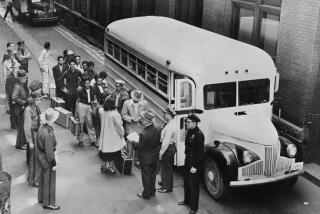Colombia residents want Germany to return stone statues

- Share via
BOGOTA, Colombia — Nearly a century ago, Konrad Preuss did pioneering work in Colombia’s most important archaeological zone, called San Agustin. But the German archaeologist also took 35 stone statues back to Germany, and now residents of the southern Colombian region where he worked have mounted a campaign to get them back.
About 1,800 residents of the Andean community of the San Agustin region signed a petition this month in a grass-roots effort to urge Colombia’s government to make a formal request for the return of the intriguing artifacts. Some of the statues are on display and others are in storage at the Ethnological Museum in Berlin’s Dahlem neighborhood.
The statues in Berlin, which are as tall as 3 feet and at least 1,000 years old, were carved to resemble “supernatural” human figures, often with feline or reptile characteristics. Little is known about the society that produced the statues, its people having vanished long before Spanish colonists arrived in the late 15th century.
With their odd headgear and goggle-like appurtenances, the statues caught the attention of Swiss author Erich von Daniken, who mentioned them in his writings as possible evidence of extraterrestrial visitors.
According to David Dellenback, a U.S. expatriate who is the driving force behind the signature collection, Preuss violated ethical, if not legal, norms in taking the statues. Dellenback said the San Agustin community hopes to emulate Peru, which succeeded in persuading Yale University to return Machu Picchu artifacts taken by explorer Hiram Bingham early last century.
“The possession of archaeological patrimony is an inalienable right of any community and doesn’t go away with time,” said Dellenback, speaking by telephone from San Agustin. The Oregon native has written two books on the area’s pre-Columbian statuary and believes that the sculptures may reflect influences of the prehistoric Olmec culture of Mexico.
Dellenback said the Colombian Culture Ministry has been “enthusiastic” about taking up the cause of the statues’ return, but so far has not made any commitment. The cultural attache at the German Embassy in Bogota did not immediately return a call asking for comment.
“For 100 years, Colombia has never asked for them back. It has nothing to do with German reluctance and everything to do with the Colombian government’s failure to even ask,” said Dellenback, who visited Berlin’s Ethnological Museum in 1992 to sketch 35 statues for one of his books.
Preuss conducted excavations in the San Agustin area in 1913 and 1914 but was unable to transport the statues back to Germany until after World War I ended in 1918. He died in 1938.
What chance do the Colombians have of getting the artifacts back? That might depend on whether Preuss violated existing laws when he put them in crates and hauled them by mule to the Caribbean coast for shipment to Europe.
Legal experts appear differ on whether there were laws at the time that prohibited such export of cultural patrimony. Some say Colombia prohibited exports of cultural patrimony as early as 1908, others argue it was not until the 1930s.
Regardless, Dellenback said, he and other San Agustin residents hope the German government will “do the right thing” and return them, particularly because 2013 marks 100 years since Preuss began excavations in San Agustin, an anniversary the Colombian government plans to commemorate with several events and conferences.
“The fact that the Colombian government has decided to celebrate Preuss has made it patent that it has forgotten what should be the most important part of the celebrations: bringing the statues back,” Dellenback said.
Kraul is a special correspondent.
More to Read
Sign up for Essential California
The most important California stories and recommendations in your inbox every morning.
You may occasionally receive promotional content from the Los Angeles Times.










